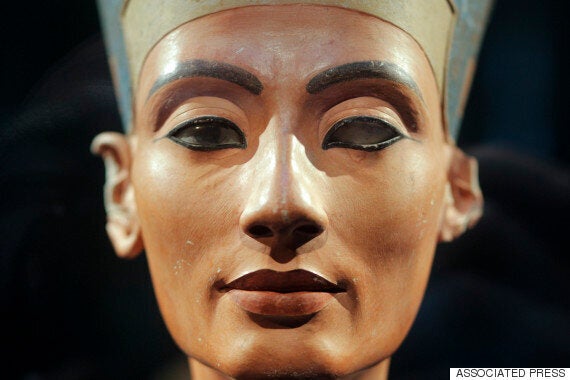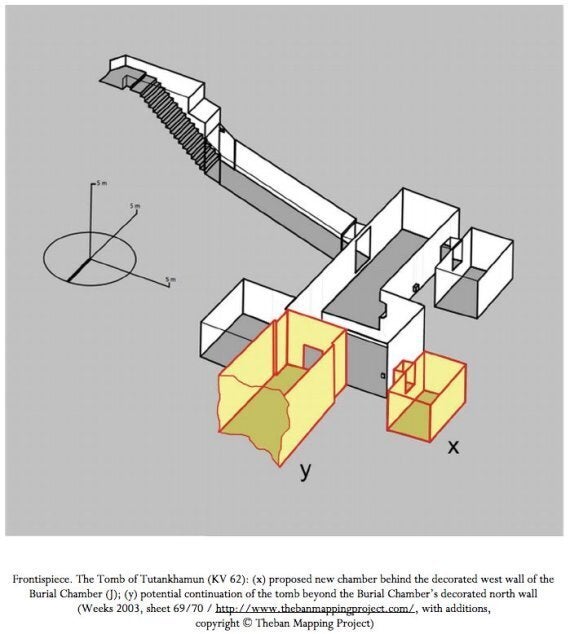The Egyptian authorities have announced they are keen to investigate the claims of a British archaeologist who says he may have found the long lost grave of Queen Nefertiti.
Nicholas Reeves believes the final resting place of the infinitely powerful royal – thought by many to be the mother of the boy King Tutankhamun – could be just yards from the tomb of her alleged son.
Reeves had earlier identified two bricked up “ghosts” of doorways after studying digital scans of the walls of Tutankhamun’s tomb in the Valley of the Kings, Luxor.
In a paper entitled The Burial of Nefertiti?, Reeves writes that he believes one of the doors leads to a storage chamber, while the other may well contain “the undisturbed burial of the tomb’s original owner – Nefertiti.”

Has the lost grave of Queen Nefertiti finally been found?
Now the Egytian authorities have promised they will move quickly to get new radar equipment needed to search for the hidden tomb.
Reeves’ theory speculates that Tutankhamun, who died unexpectedly at the age of 19, may have been rushed into an outer chamber of what was originally Nefertiti's tomb. Indeed, many archaeologists have remarked upon the modest size of the King's burial chamber.
Reeves also surmises that - if he's right - the hidden chambers could hold undiscovered artifacts that could be even more stunning than those from Tutankhamun's tomb.

Nicholas Reeves believes the Queen's tomb is actually contained in a hidden offshoot from King Tutankhamun’s (Y)
Antiquities Minister Mamdouh el-Damaty told reporters in Cairo that a plan would be presented "immediately" for non-invasive radar equipment.
Once approved, the equipment could be obtained and be at the site within three months, he said, or perhaps as early as November, for the 93rd anniversary of the 1922 discovery of Tutankhamun’s tomb.
SEE ALSO:
- Who Could It Be? Alexander The Great-Era Skeleton 'Was A Mortal Worshipped By Society'
- Mesopotamian 'Moon God' Monument Older Than Stonehenge & The Great Pyramid Discovered In Israel
- Mystery Of Hundreds Of Yellow Orbs Found In Mexico's Temple Of The Feathered Serpent
The radar equipment "will confirm whether there's something" there, said el-Damaty, who spoke after a joint visit this week with Reeves to the Valley of the Kings and King Tutankhamun’s tomb.
He added if Nefertiti's remains were found, "it would overshadow the discovery of Tutankhamun himself."

The burial mask of Egyptian Pharaoh Tutankhamun
Famed for her beauty, Nefertiti was the primary wife of Pharaoh Akhenaten, widely believed to have been Tutankhamun's father.
Tutankhamun died in mysterious circumstances in 1323 BC. Alongside the king's mummified body were hundreds of objects placed in the tomb to help Tutankhamun in his afterlife.
Tomb robbers plundered the space in the months following the boy King’s death, though Reeves believes Nefertiti’s chamber was “already forgotten, perhaps, and more likely, the robbers simply had insufficient time to investigate, choosing to focus instead on those abundant riches readily to hand.”
Three-and-a-half thousand years later the now famed archaeologist Howard Carter unearthed the King’s majestic tomb, but, says Reeves: “he lacked the technology to see beneath the tomb’s painted walls.
“Accepting the oddly positioned rock-cut niches as evidence that the Burial Chamber’s walls were completely solid, he brought his search to a close – wholly unaware that a more significant find by far may have been lying but inches from his grasp.”
Referring to Reeve’s claims, Joyce Tyldesley, a senior lecturer in Egyptology at the University of Manchester, told the Times in August: “It would not be surprising if the tomb had been intended to have additional rooms.
“I would be very surprised if this tomb was built to house the original, or first burial of Nefertiti, as it seems to me that it is highly likely that she died during her husband’s reign and so would have been buried at Amarna, the city purpose-built by Akhenaten in Middle Egypt.
“Whether or not her body was subsequently transported to Thebes by Tutankhamun, who may have been her son, is difficult to say. There is good evidence that he did move some of the Amarna royal bodies.
“But I would have expected her to be buried somewhere in the Western Valley, rather than in the centre of the Valley of Kings.”